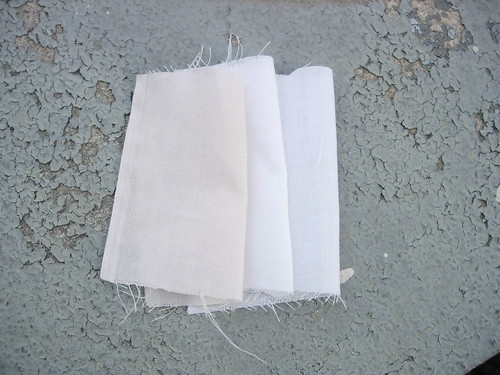I tried regular tea (Tetley tea from England), but the result was too brownish pinkish orange. So I read somewhere in all of the websites I browsed through that for making it off-white or creamy, use Chamomile. Interesting. Here are my test swatches.
 From left to right - English tea swatch, chamomile swatch, original fabric. The difference is subtle, but when comparing the other fabric I had to the original white batiste I bought, the colors just did not look right.
From left to right - English tea swatch, chamomile swatch, original fabric. The difference is subtle, but when comparing the other fabric I had to the original white batiste I bought, the colors just did not look right.Test swatches are key here. One thing to note is that a tiny little square is going to dye a LOT faster than a large amount of fabric. I learned this the hard way and had to re-dye the whole lot.
Bring your water to a boil, turn off the heat and add the tea bags. I used 2 tea bags of plain chamomile tea (check there's no other herb or flower in there - especially nothing with orange in it!) per 4 cups of water in a giant stock pot. I steeped the teabags for 20 minutes with occasional stirring.
 Steeping tea
Steeping tea Yep, I'll say it. Steep until it looks like dark urine. Gross, but accurate! It got even darker than this photo.
Yep, I'll say it. Steep until it looks like dark urine. Gross, but accurate! It got even darker than this photo. Make sure ALL of the fabric is submerged.
Make sure ALL of the fabric is submerged.Put the fabric in the pot and stir it around to make sure it is soaked through throughly. I used a smaller pot lid to keep the fabric from floating. This is from my first attempt, which was too light from 1. not dying it long enough and 2. not using enough tea bags. Make sure no bubbles get under whatever you are using to hold down the fabric. Stir occasionally (about once per hour)
Cotton takes the dye better, but this is a poly-cotton batiste so I had to experiment with things such as shrinkage and not dying at too hot a temperature. This batch ended up needing to sit in the dye bath for 6 hours to reach the light cream I was going for. Plain cotton can be boiled while dying, making the process faster. Not so for polyester! Booo. Although some dye recipes call for an overnight soak.
Once it has soaked long enough (check it for color. It will lighten a little after you rinse it) then take the fabric out and rinse it in a cold water bath until the water runs clear.
 Wring out your fabric and hang dry.
Wring out your fabric and hang dry.
 Once it is dry, (remember that it will dry lighter!) iron and use. If you hate the way it came out, do a bleach load to remove the dye and start again.
Once it is dry, (remember that it will dry lighter!) iron and use. If you hate the way it came out, do a bleach load to remove the dye and start again.
The best part of dying with Chamomile? The sweet smell of the tea every time I iron the fabric!!
Cotton takes the dye better, but this is a poly-cotton batiste so I had to experiment with things such as shrinkage and not dying at too hot a temperature. This batch ended up needing to sit in the dye bath for 6 hours to reach the light cream I was going for. Plain cotton can be boiled while dying, making the process faster. Not so for polyester! Booo. Although some dye recipes call for an overnight soak.
Once it has soaked long enough (check it for color. It will lighten a little after you rinse it) then take the fabric out and rinse it in a cold water bath until the water runs clear.
 Wring out your fabric and hang dry.
Wring out your fabric and hang dry. Once it is dry, (remember that it will dry lighter!) iron and use. If you hate the way it came out, do a bleach load to remove the dye and start again.
Once it is dry, (remember that it will dry lighter!) iron and use. If you hate the way it came out, do a bleach load to remove the dye and start again.The best part of dying with Chamomile? The sweet smell of the tea every time I iron the fabric!!

3 comments:
I think tea dye is so beautiful...when i got married remember my dress was off white almost tea colored ?My mom died my veil in lipton tea....it worked. Love that you are doing this ...your so creative
I've been searching for how to get the white antique veil I've got match to my cream wedding dress... this sounds perfect!
Could please I ask which brand of tea bags you used?
I honestly can't remember, but the are probably Bigelow. I used what they had at the grocery store.
Post a Comment